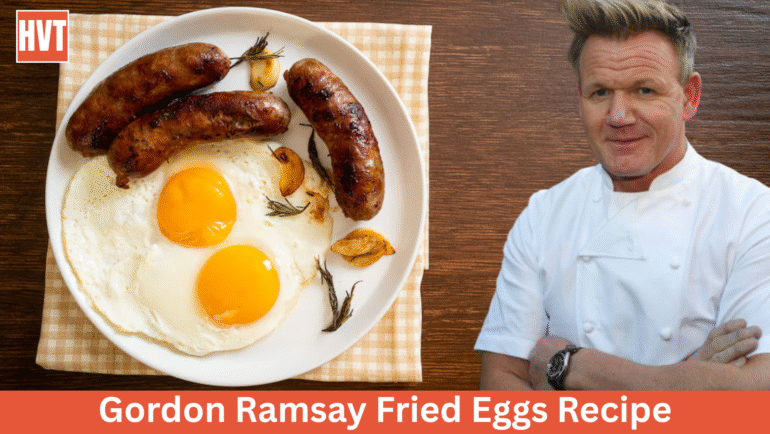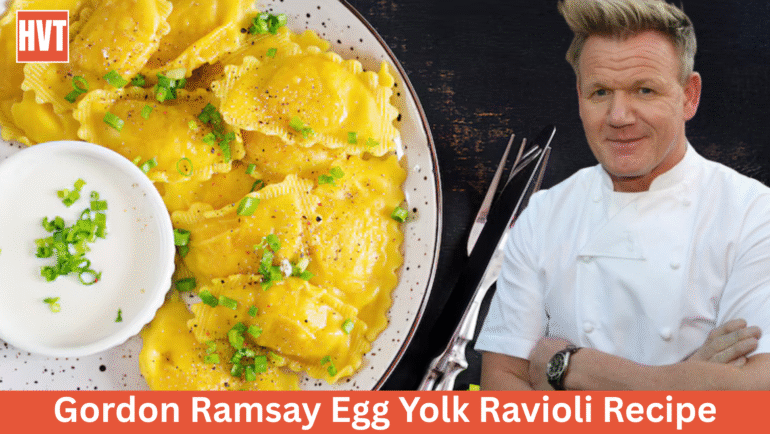
Gordon Ramsay Scrambled Eggs: Creamy, Restaurant-Worthy Breakfast in 90 Seconds Flat
Morning chaos? The viral Gordon Ramsay scrambled eggs hack isn’t just fast—it’s a nutrient-packed powerhouse. Imagine: creamy, luxurious eggs loaded with high-quality protein, healthy fats, and essential vitamins, ready in 90 seconds. No milk, no shortcuts, just smart cooking. Perfect for busy mornings when you refuse to sacrifice nutrition for speed. This isn’t just breakfast—it’s your secret weapon for a balanced, 5-star-worthy meal plan. Ready to upgrade your A.M. routine? Let’s crack into the recipe that’ll make your skillet (and your body) thank you.

What You’ll Need (No Fancy Tools, Promise!)
Let’s keep it simple—Ramsay’s method is all about technique, not gadgets. You’ll need:
Ingredients For Gordon Ramsay Recipe for Scrambled Eggs
- 3 large eggs (protein-packed!)
- 1 tbsp butter (healthy fats for energy)
- Pinch of salt and pepper
- 1 tbsp crème fraîche (goodbye, milk bloat!).
Utensils For Gordon Ramsay Recipe for Scrambled Eggs
- A nonstick pan (no sticking, no stress)
- Rubber spatula (gentle stirring = creamy texture)
- Bowl (for whisking, not showboating).
Wait, where’s the milk? Ramsay skips it to avoid diluting flavor (and your gut’s happiness). Trust us—your lactose intolerance will thank you later.
Step-by-Step: Ramsay’s 90-Second Scrambled Eggs
Step 1: Low Heat, High Patience (Butter Melting 101)
Crank the heat to low—yes, even lower than you think. Add a knob of butter to your pan and let it melt slowly, like a lazy Sunday morning. This isn’t just about avoiding burnt butter; low heat coaxes out its nutty flavor and ensures your eggs stay tender, not tough.
Imagine you’re warming a pool for the eggs to swim in, not fry in. Resist the urge to rush this step—patience here is the secret handshake to Ramsay’s club.
Step 2: Stir Like Your Breakfast Depends On It (Silicone Spatula Magic)
Crack your eggs directly into the pan (no pre-whisking needed!) and start stirring immediately with a silicone spatula. Channel your inner zen master: small, continuous circles, scraping the pan’s edges like you’re polishing a diamond. This isn’t scrambling—it’s cultivating custard.
The eggs will transform from glossy to creamy in seconds, with zero rubbery curds. Pro tip: Pretend you’re folding silk, not bulldozing concrete. If your arm gets tired, remember: 90 seconds is all it takes to change your breakfast life.
Step 3: The Crème Fraîche Finale (When to Stop the Pan!)
Here’s where most fail: remove the pan from heat the second the eggs look softly set (think: fluffy clouds, not dry dunes). Now, stir in the crème fraîche—off the burner!—to stop the cooking and add a tangy richness that milk can’t touch. Season with salt and pepper, then let the residual heat work its magic for 10 seconds.
Serve immediately on toast, because Ramsay’s eggs wait for no one. Voilà—breakfast royalty in under two minutes.

Ramsay’s 3 Non-Negotiable Rules
Rule 1: “Low Heat = Creamy Eggs” (No More Rubbery Blobs)
High heat is the enemy—it cooks eggs too fast, squeezing out moisture and turning them into dry, sad curds. Low heat gently coaxes the proteins to bond slowly, preserving their natural silkiness. Think of it as sous-vide without the machine. This isn’t just about texture; gentle cooking retains nutrients like choline and vitamin D, making your breakfast as wholesome as it is luxurious.
Rule 2: “Constant Stirring = No Curds” (Pretend It’s a Risotto)
Stirring isn’t optional—it’s your spatula’s full-time job. Continuous motion breaks up curds before they harden, creating a custard-like silkiness. Imagine you’re folding clouds, not scrambling chaos. This technique traps air, adding fluff without a single drop of milk. Bonus? The rhythmic stirring is oddly therapeutic—a breakfast meditation for busy minds.
Rule 3: “Crème Fraîche Off the Heat” (The Secret to Silky Texture)
Adding crème fraîche while the pan’s still hot? Big mistake. Pull the pan off the burner first—the residual heat gently melts the cream without overcooking the eggs. This tangy finish adds probiotics (gut-friendly perks!) and richness, replacing milk’s bloating side effects. It’s the mic drop moment that turns good eggs into greatness.
“Stop! You’re Rushing It!” (Ramsay’s Voice in Your Head)
“If you’re not sweating the small stuff, you’re doing it wrong.” Ramsay’s 90-second magic hinges on mindfulness, not multitasking.
Crank the heat? Your eggs will revolt into rubber. Stir sporadically?Say hello to uneven curds.
This isn’t a sprint—it’s a breakfast meditation. Every second counts: low heat preserves the eggs’ delicate proteins (goodbye, chalky texture), while constant stirring traps air for that cloud-like fluff. Think of it as self-care with a spatula. Trust the process—your gut (and taste buds) will thank you for the creamy, nutrient-rich payoff. Slow down, chef.
3 Luxe Twists to Impress Even Ramsay
Truffle Oil Drizzle: “1 Drop = Fancy Brunch Vibes”
Post-plating, add a whisper of truffle oil. Its earthy depth elevates eggs from “meh” to Michelin—without added calories. Bonus: truffle oil packs antioxidants for a subtle health halo.
Chives & Flaky Salt: “The 10-Second Upgrade”
Sprinkle finely chopped chives (hello, vitamin K!) and a pinch of flaky salt. The freshness cuts through richness, and the salt’s crunch? Pure texture sorcery.
Smoked Salmon Sidekick: “Because You’re Worth It”
Fold in silky smoked salmon ribbons after cooking. Rich in omega-3s, it turns breakfast into a brain-boosting feast. Pro tip: Pair with rye toast for fiber.
Frequently Asked Question for Scrambled Eggs Recipe
What are the benefits of eating scrambled eggs?
Scrambled eggs are protein powerhouses, rich in vitamins B12 and D, and choline for brain health. They’re quick, nutrient-dense, and keep you full longer—perfect for a balanced breakfast.
Should you eat scrambled eggs every day?
Yes! Eggs are nutrient-packed, but rotate fats (try olive oil) and pair with veggies. Stick to 1-2 daily unless your doctor says otherwise.
What not to do when making scrambled eggs?
Avoid high heat (rubber alert!), aggressive stirring, or adding milk. And never cook until “done”—pull them off early for creaminess.
What are 3 tips for perfect scrambled eggs?
Low heat, gentle stirring, and crème fraîche off the heat. Master these, and say goodbye to bland scrambles.
How do restaurants make eggs so fluffy?
Patience, not magic! Low heat + constant stirring traps air. Crème fraîche adds silkiness—no shortcuts needed.
Should you add butter to scrambled eggs?
Yes—it’s flavor gold. Use 1 tbsp for 3 eggs. For a lighter twist, mix butter with olive oil.
What makes fluffier eggs, water or milk?
Neither! Crème fraîche reigns supreme. For dairy-free fluff, try a splash of water or coconut cream.
Final Learnings
Who said nutritious can’t be delicious? Gordon Ramsay’s scrambled eggs prove that health and flavor aren’t enemies—they’re brunch soulmates. Eggs, often dismissed as “boring,” are actually nature’s MVP: affordable, protein-packed, and brimming with brain-boosting choline.
But let’s be real—nobody wants to choke down bland fluff. Ramsay’s 90-second hack solves the “healthy = tasteless” dilemma, turning simple ingredients into a creamy, restaurant-worthy meal that fuels your body and your inner foodie.
Ready to level up? Explore our FITNESS section for workouts that pair perfectly with protein-rich meals, dive into NUTRITION for science-backed eating hacks, or check out HOT TOPICS for the latest wellness trends. Hungry for more chef-approved healthy recipes? [Click here]—your skillet (and six-pack) will thank you.




